Camp keep vocabulary hazards
Download as ppt, pdf1 like603 views
This document lists potential hazards campers may encounter at Camp KEEP Vocabulary including poison oak, stinging nettle, poison hemlock, deadly nightshade, rattlesnake, mountain lion, and ticks.
1 of 8
Download to read offline
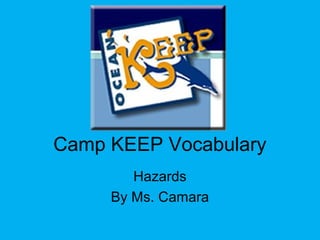
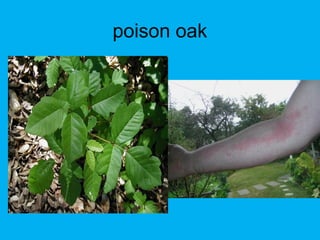
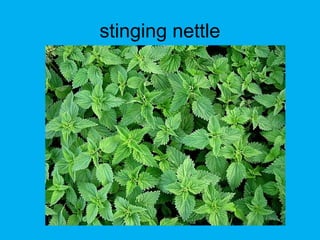

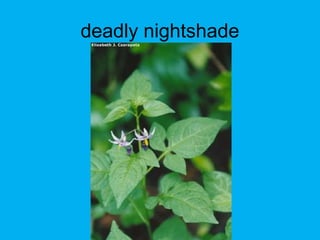
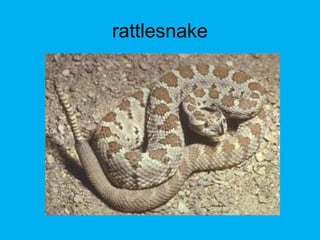
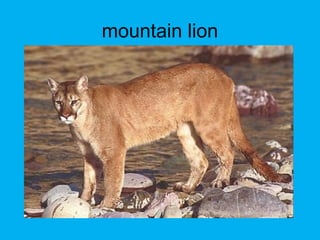
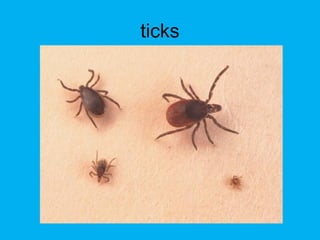
Ad
Recommended
Survival guide
Survival guideLawrenceoArabi
╠²
This guide provides advice on how to survive worst-case scenarios. It is written by Race Stryker and aims to help readers prepare for and handle dangerous situations through Captain Calamity's expertise and lessons learned. The guide gives concise tips and strategies for staying safe in emergencies.Camp keep vocabulary campus words
Camp keep vocabulary campus wordsJolene Berg
╠²
This document lists vocabulary words related to Camp KEEP including naturalists, counselors, facilities like trailers and a dome, activities such as hiking and campfires, educational areas like a discovery zone and tide pools, and other places on the campus like showers and a greenhouse.Camp keep vocabulary ocean
Camp keep vocabulary oceanJolene Berg
╠²
This document contains vocabulary words related to ocean ecology. It lists various habitats like estuaries, sand dunes, and rocky intertidal zones. It also lists many different types of aquatic invertebrates that live in tidepools, like sea anemones, barnacles, sea stars, and hermit crabs. Finally it discusses tide-related terms like high tide, low tide, and the gravitational pull of the sun and moon that causes tides.Summer Day Camp Keeps Kids Learning
Summer Day Camp Keeps Kids LearningBuzz Marketing Pros
╠²
Summer day camps provide children with opportunities to learn and engage in various activities such as nature hikes, sports, arts and crafts, and field trips, fostering personal growth and creativity. Camps emphasize teamwork, healthy risks, and exploration of new interests while ensuring safety and enjoyment. Camp Maplewood offers these experiences to children aged birth to 14 in the greater Boston and Rhode Island areas.Phoebe the Spy
Phoebe the SpyJolene Berg
╠²
Phoebe the Spy summarizes a vocabulary list for Mrs. Berg's class in 3 sentences or less:
The document defines vocabulary words for Mrs. Berg's class including nautical terms like mast and sail, emotions like anxious and dread, occupations like housekeeper and patriot, and other words like scraps, shawl, and unruffled. It provides definitions for over 30 words that Phoebe may encounter in her spying activities or daily life in the late 18th century. The list appears to be helping Phoebe expand her vocabulary to better understand conversations and blend in with different people and situations.Salt rocks! vocab ch 4 5
Salt rocks! vocab ch 4 5Jolene Berg
╠²
Salt Rocks! provides vocabulary words related to salt mining and geology, including terms like dissolved, evaporate, freeze, haul, mine, mountain, natural, precious, and villages. The document defines key words and concepts for understanding how salt is extracted from places in nature and used in various applications.Salt rocks! vocab ch 1 3
Salt rocks! vocab ch 1 3Jolene Berg
╠²
This document defines key vocabulary words from chapters 1-3 of a book about salt, including definitions for animal, blood, body, crystal, flavor, grain, mineral, mummies, muscles, plant, preserve, refrigerator, rock, salt, seasoning, and spoil. It also provides the definitions of control, harmful, invented, live, and sodium.Mayan
MayanJolene Berg
╠²
The document summarizes key aspects of the ancient Maya civilization from 400 BCE to 900 CE. It describes the Maya's geographic region spanning Guatemala, the Pacific coast, and the Yucatan peninsula. Every Maya city contained an impressive palace, bustling marketplace, open-air plaza, and at least one huge pyramid, large temple, and ball court. The Maya worshipped gods of nature and had powerful priests who could communicate with the gods and directed many aspects of life.Incas
IncasJolene Berg
╠²
The Incas started as a small tribe in Peru but built a vast empire through strong central government and control of the population. The Sapa Inca was the all-powerful ruler who put relatives in positions of power. Common people had no freedom and were tightly controlled, paying taxes through required labor. Harsh laws and inspections kept people compliant with government demands over their lives and labor. The empire expanded due to geographical barriers like mountains and jungle that the Incas traversed using an extensive network of well-built roads connecting their realm.Salt rocks! vocab ch 1 2
Salt rocks! vocab ch 1 2Jolene Berg
╠²
This document defines key vocabulary terms from Chapters 1 and 2 of the book "Salt Rocks!", including animals, blood, body, control, crystal, flavor, grain, harmful, invented, live, mineral, mummies, muscles, plant, preserve, refrigerator, rock, salt, seasoning, sodium, and spoil.I pad apps for language development
I pad apps for language developmentJolene Berg
╠²
The document provides an overview of iPad apps to support language, grammar, writing, and reading development for students presented by Jolene Berg, a teacher of the deaf and hard of hearing for 25 years. It describes several free and paid apps for vocabulary, grammar, writing, and reading and recommends websites for reviewing educational apps. Contact information is provided for the presenter to learn more about using iPad apps to support student learning.Strategies and resources for developing vocabulary with diverse learners
Strategies and resources for developing vocabulary with diverse learnersJolene Berg
╠²
This document provides an overview of strategies and resources for developing vocabulary with diverse learners as presented by Jolene Berg. Berg has over 25 years of teaching experience, including teaching deaf and hard of hearing students from preschool to 12th grade. The presentation discusses using PowerPoints, flashcards, highlighting, interactive whiteboards, games, and apps to engage students in learning new vocabulary. A variety of free online resources are also introduced, such as EdHelper.com, EnglishRaven.com, What2Learn.com, and Learning A-Z.com.The knight at dawn 7 10
The knight at dawn 7 10Jolene Berg
╠²
This document contains vocabulary words and definitions from chapters 7-10 of a book. It defines 13 words: barrel, cantered, clinging, creepy, damp, dismounted, embankment, grove, passage, precipice, slither, storeroom, and tunnel. The words are related to a knight, armor, forests, cliffs, secret doors, and underground paths.Telling time to hour
Telling time to hourJolene Berg
╠²
1) The document is about telling time to the hour and distinguishing between the minute and hour hands on an analog clock.
2) The long hand is the minute hand, which moves in 5 minute increments, while the short hand is the hour hand, which moves in 1 hour increments.
3) The document guides the reader through telling the time as each hour passes from 1 o'clock to 12 o'clock.Math with technology
Math with technologyJolene Berg
╠²
The document discusses different types of technology that can be used for math instruction including a single computer classroom, a computer and projector, multiple computers, an interactive whiteboard, iPads/iPods, cameras, and websites and apps. It provides examples of how each technology can be used for centers, group activities, presentations, and viewing lessons. URLs are also listed for the teacher's website, interactive whiteboard resources, recommended iPad apps, online math games, and ways to obtain technology through grants.The knight at dawn 7 10
The knight at dawn 7 10Jolene Berg
╠²
This document contains vocabulary words and definitions from chapters 7-10 of a book. It defines 13 words: barrel, cantered, clinging, creepy, damp, dismounted, embankment, grove, passage, precipice, slither, storeroom, and tunnel. The words are related to a knight and include objects, actions, locations, and armor pieces that may be encountered in the described chapters.Atoms, molecules, and the elements
Atoms, molecules, and the elementsJolene Berg
╠²
This document defines key chemistry terms including:
- Atoms as the basic building blocks of matter and elements.
- Chemical formulas as a way to express the atoms in a compound.
- Compounds as substances made of two or more chemically bonded elements.
- The three states of matter - solids, liquids, and gases.
- Other terms like ions, molecules, organic and inorganic substances.Teaching research in the elementary classroomfinak
Teaching research in the elementary classroomfinakJolene Berg
╠²
The document provides an overview of a presentation on teaching research and informational writing in elementary classrooms. It outlines a 10-step "CB Research Model" and discusses practical ideas and tools for teaching each step, including choosing topics, developing research questions, evaluating sources, taking notes, and organizing information.Research writing
Research writingJolene Berg
╠²
- A research paper uses information from sources like books, articles, and the internet to tell readers about a topic. It requires choosing a topic, narrowing the topic into specific questions, creating an outline to organize research, taking notes from reliable sources, writing a rough draft, revising for clarity, editing for errors, and publishing the final draft.
- Students should avoid plagiarism by properly citing sources and creating a bibliography. Reliable sources include library books, approved websites like .edu and .gov sites, and sources recommended by teachers. Wikipedia is not considered a reliable source.
- The example topic of the history of Thanksgiving is used to demonstrate how to narrow a topic into questions, create an outline withInteractive guide research
Interactive guide researchJolene Berg
╠²
The document provides an overview of the Information Literacy Process Model, which is a nine-step guide for conducting research. It outlines each of the nine steps, including encountering the task, exploring questions, searching and locating resources, collecting and organizing information, analyzing and evaluating sources, synthesizing information to solve problems, applying new understanding, communicating findings, and reflecting on the research process. For each step, it provides activities and quizzes to help students work through the process of researching and completing an assignment.Pompeii...Buried Alive! ch. 3
Pompeii...Buried Alive! ch. 3Jolene Berg
╠²
Pompeii was buried alive when Mount Vesuvius erupted in 79 AD. Archaeologists have been digging at the site and have found many artifacts that provide information about daily life in Pompeii. Famous plaster casts of Pompeii residents were also discovered, showing their final moments before the city was buried in ash and stone.Pompeii...Buried Alive! ch. 3
Pompeii...Buried Alive! ch. 3Jolene Berg
╠²
Pompeii was buried alive when Mount Vesuvius erupted in 79 AD. Archaeologists have been digging at Pompeii and slowly uncovering the remains of the ancient city. They have found skeletons of people frozen in their final moments, as well as artifacts like mosaics, letters, and pictures carved into stone that provide clues about daily life in Pompeii.The Legend of Old Befana Vocabulary
The Legend of Old Befana VocabularyJolene Berg
╠²
The document contains vocabulary words for a class with definitions including words like "coals", "cranky", "lullaby", "miracles", "outskirts", and "village". The words are related to an Italian folk tale called "The Legend of Old Befana" and include descriptions of gifts, sounds, locations, emotions, and other elements that could be part of the story.Pompeii ch 2
Pompeii ch 2Jolene Berg
╠²
The document provides vocabulary definitions related to Pompeii being buried alive by the eruption of Mount Vesuvius. It defines 22 words describing the volcanic eruption and its effects, including ash, breathe, cloud, covered, cracking, crashing, dark, dust, enormous, escape, everyone, forgot, ground, higher, horrible, pebbles, piled, poisonous, pouring, protect, saved, scream, sea, smell, sound, suddenly, torches, trapped, tremble, waves, and windows.Vacation under the volcano ch 5 10
Vacation under the volcano ch 5 10Jolene Berg
╠²
This document provides vocabulary words related to volcanoes and vacationing near a volcano. Some of the key words include: ash, blast, buried, erupting, lava, magma, pumice, rescuing, risked, rumbling, trembling, and vanished. The vocabulary focuses on describing the effects of volcanic eruptions such as explosions, rocks being thrown from the volcano, things being covered or hidden by ash and lava, and the danger involved with living near an active volcano.Rock introduction
Rock introductionJolene Berg
╠²
The document discusses different types of rocks, where they are found, their properties, how they change over time, and how they are used. It explains that rocks can be hard or soft, one color or many colors. It also outlines three main types of rocks - sedimentary rocks which are formed from compressed layers, metamorphic rocks which are formed from changes to other rocks due to heat and pressure, and igneous rocks which are formed when melted rock hardens.Mosaics
MosaicsJolene Berg
╠²
The document provides instructions for students to design and create a Roman mosaic. It explains that Romans decorated the floors and walls of their villas with elaborate mosaics showing scenes from everyday life and mythology. To make a mosaic, students will plan a design, transfer it to a wooden frame, and place small tiles into wet plaster or glue according to the design. When complete, they will grout, sand, varnish, and polish their mosaic.Pompeii
PompeiiJolene Berg
╠²
Pompeii was an ancient Roman town that was buried alive in 79 AD when Mount Vesuvius erupted. The volcanic eruption destroyed the town and killed many of its residents through explosions, heat, and ash. Archeologists have since excavated Pompeii and found remains of the town's buildings, artifacts, and even bodies of those trapped in the disaster.Securing Account Lifecycles in the Age of Deepfakes.pptx
Securing Account Lifecycles in the Age of Deepfakes.pptxFIDO Alliance
╠²
Securing Account Lifecycles in the Age of DeepfakesFrom Manual to Auto Searching- FME in the Driver's Seat
From Manual to Auto Searching- FME in the Driver's SeatSafe Software
╠²
Finding a specific car online can be a time-consuming task, especially when checking multiple dealer websites. A few years ago, I faced this exact problem while searching for a particular vehicle in New Zealand. The local classified platform, Trade Me (similar to eBay), wasnŌĆÖt yielding any results, so I expanded my search to second-hand dealer sitesŌĆöonly to realise that periodically checking each one was going to be tedious. ThatŌĆÖs when I noticed something interesting: many of these websites used the same platform to manage their inventories. Recognising this, I reverse-engineered the platformŌĆÖs structure and built an FME workspace that automated the search process for me. By integrating API calls and setting up periodic checks, I received real-time email alerts when matching cars were listed. In this presentation, IŌĆÖll walk through how I used FME to save hours of manual searching by creating a custom car-finding automation system. While FME canŌĆÖt buy a car for youŌĆöyetŌĆöit can certainly help you find the one youŌĆÖre after!More Related Content
More from Jolene Berg (20)
Incas
IncasJolene Berg
╠²
The Incas started as a small tribe in Peru but built a vast empire through strong central government and control of the population. The Sapa Inca was the all-powerful ruler who put relatives in positions of power. Common people had no freedom and were tightly controlled, paying taxes through required labor. Harsh laws and inspections kept people compliant with government demands over their lives and labor. The empire expanded due to geographical barriers like mountains and jungle that the Incas traversed using an extensive network of well-built roads connecting their realm.Salt rocks! vocab ch 1 2
Salt rocks! vocab ch 1 2Jolene Berg
╠²
This document defines key vocabulary terms from Chapters 1 and 2 of the book "Salt Rocks!", including animals, blood, body, control, crystal, flavor, grain, harmful, invented, live, mineral, mummies, muscles, plant, preserve, refrigerator, rock, salt, seasoning, sodium, and spoil.I pad apps for language development
I pad apps for language developmentJolene Berg
╠²
The document provides an overview of iPad apps to support language, grammar, writing, and reading development for students presented by Jolene Berg, a teacher of the deaf and hard of hearing for 25 years. It describes several free and paid apps for vocabulary, grammar, writing, and reading and recommends websites for reviewing educational apps. Contact information is provided for the presenter to learn more about using iPad apps to support student learning.Strategies and resources for developing vocabulary with diverse learners
Strategies and resources for developing vocabulary with diverse learnersJolene Berg
╠²
This document provides an overview of strategies and resources for developing vocabulary with diverse learners as presented by Jolene Berg. Berg has over 25 years of teaching experience, including teaching deaf and hard of hearing students from preschool to 12th grade. The presentation discusses using PowerPoints, flashcards, highlighting, interactive whiteboards, games, and apps to engage students in learning new vocabulary. A variety of free online resources are also introduced, such as EdHelper.com, EnglishRaven.com, What2Learn.com, and Learning A-Z.com.The knight at dawn 7 10
The knight at dawn 7 10Jolene Berg
╠²
This document contains vocabulary words and definitions from chapters 7-10 of a book. It defines 13 words: barrel, cantered, clinging, creepy, damp, dismounted, embankment, grove, passage, precipice, slither, storeroom, and tunnel. The words are related to a knight, armor, forests, cliffs, secret doors, and underground paths.Telling time to hour
Telling time to hourJolene Berg
╠²
1) The document is about telling time to the hour and distinguishing between the minute and hour hands on an analog clock.
2) The long hand is the minute hand, which moves in 5 minute increments, while the short hand is the hour hand, which moves in 1 hour increments.
3) The document guides the reader through telling the time as each hour passes from 1 o'clock to 12 o'clock.Math with technology
Math with technologyJolene Berg
╠²
The document discusses different types of technology that can be used for math instruction including a single computer classroom, a computer and projector, multiple computers, an interactive whiteboard, iPads/iPods, cameras, and websites and apps. It provides examples of how each technology can be used for centers, group activities, presentations, and viewing lessons. URLs are also listed for the teacher's website, interactive whiteboard resources, recommended iPad apps, online math games, and ways to obtain technology through grants.The knight at dawn 7 10
The knight at dawn 7 10Jolene Berg
╠²
This document contains vocabulary words and definitions from chapters 7-10 of a book. It defines 13 words: barrel, cantered, clinging, creepy, damp, dismounted, embankment, grove, passage, precipice, slither, storeroom, and tunnel. The words are related to a knight and include objects, actions, locations, and armor pieces that may be encountered in the described chapters.Atoms, molecules, and the elements
Atoms, molecules, and the elementsJolene Berg
╠²
This document defines key chemistry terms including:
- Atoms as the basic building blocks of matter and elements.
- Chemical formulas as a way to express the atoms in a compound.
- Compounds as substances made of two or more chemically bonded elements.
- The three states of matter - solids, liquids, and gases.
- Other terms like ions, molecules, organic and inorganic substances.Teaching research in the elementary classroomfinak
Teaching research in the elementary classroomfinakJolene Berg
╠²
The document provides an overview of a presentation on teaching research and informational writing in elementary classrooms. It outlines a 10-step "CB Research Model" and discusses practical ideas and tools for teaching each step, including choosing topics, developing research questions, evaluating sources, taking notes, and organizing information.Research writing
Research writingJolene Berg
╠²
- A research paper uses information from sources like books, articles, and the internet to tell readers about a topic. It requires choosing a topic, narrowing the topic into specific questions, creating an outline to organize research, taking notes from reliable sources, writing a rough draft, revising for clarity, editing for errors, and publishing the final draft.
- Students should avoid plagiarism by properly citing sources and creating a bibliography. Reliable sources include library books, approved websites like .edu and .gov sites, and sources recommended by teachers. Wikipedia is not considered a reliable source.
- The example topic of the history of Thanksgiving is used to demonstrate how to narrow a topic into questions, create an outline withInteractive guide research
Interactive guide researchJolene Berg
╠²
The document provides an overview of the Information Literacy Process Model, which is a nine-step guide for conducting research. It outlines each of the nine steps, including encountering the task, exploring questions, searching and locating resources, collecting and organizing information, analyzing and evaluating sources, synthesizing information to solve problems, applying new understanding, communicating findings, and reflecting on the research process. For each step, it provides activities and quizzes to help students work through the process of researching and completing an assignment.Pompeii...Buried Alive! ch. 3
Pompeii...Buried Alive! ch. 3Jolene Berg
╠²
Pompeii was buried alive when Mount Vesuvius erupted in 79 AD. Archaeologists have been digging at the site and have found many artifacts that provide information about daily life in Pompeii. Famous plaster casts of Pompeii residents were also discovered, showing their final moments before the city was buried in ash and stone.Pompeii...Buried Alive! ch. 3
Pompeii...Buried Alive! ch. 3Jolene Berg
╠²
Pompeii was buried alive when Mount Vesuvius erupted in 79 AD. Archaeologists have been digging at Pompeii and slowly uncovering the remains of the ancient city. They have found skeletons of people frozen in their final moments, as well as artifacts like mosaics, letters, and pictures carved into stone that provide clues about daily life in Pompeii.The Legend of Old Befana Vocabulary
The Legend of Old Befana VocabularyJolene Berg
╠²
The document contains vocabulary words for a class with definitions including words like "coals", "cranky", "lullaby", "miracles", "outskirts", and "village". The words are related to an Italian folk tale called "The Legend of Old Befana" and include descriptions of gifts, sounds, locations, emotions, and other elements that could be part of the story.Pompeii ch 2
Pompeii ch 2Jolene Berg
╠²
The document provides vocabulary definitions related to Pompeii being buried alive by the eruption of Mount Vesuvius. It defines 22 words describing the volcanic eruption and its effects, including ash, breathe, cloud, covered, cracking, crashing, dark, dust, enormous, escape, everyone, forgot, ground, higher, horrible, pebbles, piled, poisonous, pouring, protect, saved, scream, sea, smell, sound, suddenly, torches, trapped, tremble, waves, and windows.Vacation under the volcano ch 5 10
Vacation under the volcano ch 5 10Jolene Berg
╠²
This document provides vocabulary words related to volcanoes and vacationing near a volcano. Some of the key words include: ash, blast, buried, erupting, lava, magma, pumice, rescuing, risked, rumbling, trembling, and vanished. The vocabulary focuses on describing the effects of volcanic eruptions such as explosions, rocks being thrown from the volcano, things being covered or hidden by ash and lava, and the danger involved with living near an active volcano.Rock introduction
Rock introductionJolene Berg
╠²
The document discusses different types of rocks, where they are found, their properties, how they change over time, and how they are used. It explains that rocks can be hard or soft, one color or many colors. It also outlines three main types of rocks - sedimentary rocks which are formed from compressed layers, metamorphic rocks which are formed from changes to other rocks due to heat and pressure, and igneous rocks which are formed when melted rock hardens.Mosaics
MosaicsJolene Berg
╠²
The document provides instructions for students to design and create a Roman mosaic. It explains that Romans decorated the floors and walls of their villas with elaborate mosaics showing scenes from everyday life and mythology. To make a mosaic, students will plan a design, transfer it to a wooden frame, and place small tiles into wet plaster or glue according to the design. When complete, they will grout, sand, varnish, and polish their mosaic.Pompeii
PompeiiJolene Berg
╠²
Pompeii was an ancient Roman town that was buried alive in 79 AD when Mount Vesuvius erupted. The volcanic eruption destroyed the town and killed many of its residents through explosions, heat, and ash. Archeologists have since excavated Pompeii and found remains of the town's buildings, artifacts, and even bodies of those trapped in the disaster.Recently uploaded (20)
Securing Account Lifecycles in the Age of Deepfakes.pptx
Securing Account Lifecycles in the Age of Deepfakes.pptxFIDO Alliance
╠²
Securing Account Lifecycles in the Age of DeepfakesFrom Manual to Auto Searching- FME in the Driver's Seat
From Manual to Auto Searching- FME in the Driver's SeatSafe Software
╠²
Finding a specific car online can be a time-consuming task, especially when checking multiple dealer websites. A few years ago, I faced this exact problem while searching for a particular vehicle in New Zealand. The local classified platform, Trade Me (similar to eBay), wasnŌĆÖt yielding any results, so I expanded my search to second-hand dealer sitesŌĆöonly to realise that periodically checking each one was going to be tedious. ThatŌĆÖs when I noticed something interesting: many of these websites used the same platform to manage their inventories. Recognising this, I reverse-engineered the platformŌĆÖs structure and built an FME workspace that automated the search process for me. By integrating API calls and setting up periodic checks, I received real-time email alerts when matching cars were listed. In this presentation, IŌĆÖll walk through how I used FME to save hours of manual searching by creating a custom car-finding automation system. While FME canŌĆÖt buy a car for youŌĆöyetŌĆöit can certainly help you find the one youŌĆÖre after!Oh, the Possibilities - Balancing Innovation and Risk with Generative AI.pdf
Oh, the Possibilities - Balancing Innovation and Risk with Generative AI.pdfPriyanka Aash
╠²
Oh, the Possibilities - Balancing Innovation and Risk with Generative AISmarter Aviation Data Management: Lessons from Swedavia Airports and Sweco
Smarter Aviation Data Management: Lessons from Swedavia Airports and SwecoSafe Software
╠²
Managing airport and airspace data is no small task, especially when youŌĆÖre expected to deliver it in AIXM format without spending a fortune on specialized tools. But what if there was a smarter, more affordable way?
Join us for a behind-the-scenes look at how Sweco partnered with Swedavia, the Swedish airport operator, to solve this challenge using FME and Esri.
Learn how they built automated workflows to manage periodic updates, merge airspace data, and support data extracts ŌĆō all while meeting strict government reporting requirements to the Civil Aviation Administration of Sweden.
Even better? Swedavia built custom services and applications that use the FME Flow REST API to trigger jobs and retrieve results ŌĆō streamlining tasks like securing the quality of new surveyor data, creating permdelta and baseline representations in the AIS schema, and generating AIXM extracts from their AIS data.
To conclude, FME expert Dean Hintz will walk through a GeoBorders reading workflow and highlight recent enhancements to FMEŌĆÖs AIXM (Aeronautical Information Exchange Model) processing and interpretation capabilities.
Discover how airports like Swedavia are harnessing the power of FME to simplify aviation data management, and how you can too.PyCon SG 25 - Firecracker Made Easy with Python.pdf
PyCon SG 25 - Firecracker Made Easy with Python.pdfMuhammad Yuga Nugraha
╠²
Explore the ease of managing Firecracker microVM with the firecracker-python. In this session, I will introduce the basics of Firecracker microVM and demonstrate how this custom SDK facilitates microVM operations easily. We will delve into the design and development process behind the SDK, providing a behind-the-scenes look at its creation and features. While traditional Firecracker SDKs were primarily available in Go, this module brings a simplicity of Python to the table.Information Security Response Team Nepal_npCERT_Vice_President_Sudan_Jha.pdf
Information Security Response Team Nepal_npCERT_Vice_President_Sudan_Jha.pdfICT Frame Magazine Pvt. Ltd.
╠²
Artificial Intelligence (AI) is rapidly changing the face of cybersecurity across the globe. In Nepal, the shift is already underway. Vice President of the Information Security Response Team Nepal (npCERT) and Information Security Consultant at One Cover Pvt. Ltd., Sudan Jha, recently presented an in-depth workshop on how AI can strengthen national security and digital defenses.cnc-processing-centers-centateq-p-110-en.pdf
cnc-processing-centers-centateq-p-110-en.pdfAmirStern2
╠²
ū×ū©ūøū¢ ūóūÖūæūĢūōūÖūØ ū¬ūóū®ūÖūÖū¬ūÖ ūæūóū£ 3/4/5 ū”ūÖū©ūÖūØ, ūóūō 22 ūöūŚū£ūżūĢū¬ ūøū£ūÖūØ ūóūØ ūøū£ ūÉūżū®ū©ūĢūÖūĢū¬ ūöūóūÖūæūĢūō ūöūōū©ūĢū®ūĢū¬.╠²ūæūóū£ ū®ūśūŚ ūóūæūĢūōūö ūÆūōūĢū£ ūĢū×ūŚū®ūæ ūĀūĢūŚ ūĢū¦ū£ ū£ūöūżūóū£ūö ūæū®ūżūö ūöūóūæū©ūÖū¬/ū©ūĢūĪūÖū¬/ūÉūĀūÆū£ūÖū¬/ūĪūżū©ūōūÖū¬/ūóū©ūæūÖū¬ ūĢūóūĢūō..
ū×ūĪūĢūÆū£ ū£ūæū”ūó ūżūóūĢū£ūĢū¬ ūóūÖūæūĢūō ū®ūĢūĀūĢū¬ ūöū×ū¬ūÉūÖū×ūĢū¬ ū£ūóūĀūżūÖūØ ū®ūĢūĀūÖūØ: ū¦ūÖūōūĢūŚ ūÉūĀūøūÖ, ūÉūĢūżū¦ūÖ, ūĀūÖūĪūĢū©, ūĢūøū©ūĪūĢūØ ūÉūĀūøūÖ.OpenACC and Open Hackathons Monthly Highlights June 2025
OpenACC and Open Hackathons Monthly Highlights June 2025OpenACC
╠²
The OpenACC organization focuses on enhancing parallel computing skills and advancing interoperability in scientific applications through hackathons and training. The upcoming 2025 Open Accelerated Computing Summit (OACS) aims to explore the convergence of AI and HPC in scientific computing and foster knowledge sharing. This year's OACS welcomes talk submissions from a variety of topics, from Using Standard Language Parallelism to Computer Vision Applications. The document also highlights several open hackathons, a call to apply for NVIDIA Academic Grant Program and resources for optimizing scientific applications using OpenACC directives.Techniques for Automatic Device Identification and Network Assignment.pdf
Techniques for Automatic Device Identification and Network Assignment.pdfPriyanka Aash
╠²
Techniques for Automatic Device Identification and Network AssignmentThe Future of AI Agent Development Trends to Watch.pptx
The Future of AI Agent Development Trends to Watch.pptxLisa ward
╠²
The Future of AI Agent Development: Trends to Watch explores emerging innovations shaping smarter, more autonomous AI solutions for businesses and technology.
FIDO Seminar: Targeting Trust: The Future of Identity in the Workforce.pptx
FIDO Seminar: Targeting Trust: The Future of Identity in the Workforce.pptxFIDO Alliance
╠²
FIDO Seminar: Targeting Trust: The Future of Identity in the Workforce9-1-1 Addressing: End-to-End Automation Using FME
9-1-1 Addressing: End-to-End Automation Using FMESafe Software
╠²
This session will cover a common use case for local and state/provincial governments who create and/or maintain their 9-1-1 addressing data, particularly address points and road centerlines. In this session, you'll learn how FME has helped Shelby County 9-1-1 (TN) automate the 9-1-1 addressing process; including automatically assigning attributes from disparate sources, on-the-fly QAQC of said data, and reporting. The FME logic that this presentation will cover includes: Table joins using attributes and geometry, Looping in custom transformers, Working with lists and Change detection.OWASP Barcelona 2025 Threat Model Library
OWASP Barcelona 2025 Threat Model LibraryPetraVukmirovic
╠²
Threat Model Library Launch at OWASP Barcelona 2025
https://owasp.org/www-project-threat-model-library/FIDO Seminar: Perspectives on Passkeys & Consumer Adoption.pptx
FIDO Seminar: Perspectives on Passkeys & Consumer Adoption.pptxFIDO Alliance
╠²
FIDO Seminar: Perspectives on Passkeys & Consumer AdoptionCapCut Pro Crack For PC Latest Version {Fully Unlocked} 2025
CapCut Pro Crack For PC Latest Version {Fully Unlocked} 2025pcprocore
╠²
¤æēØŚĪØŚ╝ØśüØŚ▓:ØŚ¢ØŚ╝ØŚĮØśå ØŚ╣ØŚČØŚ╗ØŚĖ & ØŚĮØŚ«ØśĆØśüØŚ▓ ØŚČØŚ╗ØśüØŚ╝ ØŚÜØŚ╝ØŚ╝ØŚ┤ØŚ╣ØŚ▓ ØŚ╗ØŚ▓Øśä ØśüØŚ«ØŚ»> https://pcprocore.com/ ¤æłŌŚĆ
CapCut Pro Crack is a powerful tool that has taken the digital world by storm, offering users a fully unlocked experience that unleashes their creativity. With its user-friendly interface and advanced features, itŌĆÖs no wonder why aspiring videographers are turning to this software for their projects.Powering Multi-Page Web Applications Using Flow Apps and FME Data Streaming
Powering Multi-Page Web Applications Using Flow Apps and FME Data StreamingSafe Software
╠²
Unleash the potential of FME Flow to build and deploy advanced multi-page web applications with ease. Discover how Flow Apps and FMEŌĆÖs data streaming capabilities empower you to create interactive web experiences directly within FME Platform. Without the need for dedicated web-hosting infrastructure, FME enhances both data accessibility and user experience. Join us to explore how to unlock the full potential of FME for your web projects and seamlessly integrate data-driven applications into your workflows.Wenn alles versagt - IBM Tape sch├╝tzt, was z├żhlt! Und besonders mit dem neust...
Wenn alles versagt - IBM Tape sch├╝tzt, was z├żhlt! Und besonders mit dem neust...Josef Weingand
╠²
IBM LTO10The Future of Data, AI, and AR: Innovation Inspired by You.pdf
The Future of Data, AI, and AR: Innovation Inspired by You.pdfSafe Software
╠²
The future of FME is inspired by you. We can't wait to show you what's ahead for FME and Safe Software. The Future of Technology: 2025-2125 by Saikat Basu.pdf
The Future of Technology: 2025-2125 by Saikat Basu.pdfSaikat Basu
╠²
A peek into the next 100 years of technology. From Generative AI to Global AI networks to Martian Colonisation to Interstellar exploration to Industrial Nanotechnology to Artificial Consciousness, this is a journey you don't want to miss. Which ones excite you the most? Which ones are you apprehensive about? Feel free to comment! Let the conversation begin!Information Security Response Team Nepal_npCERT_Vice_President_Sudan_Jha.pdf
Information Security Response Team Nepal_npCERT_Vice_President_Sudan_Jha.pdfICT Frame Magazine Pvt. Ltd.
╠²
Ad
Camp keep vocabulary hazards
- 1. Camp KEEP Vocabulary Hazards By Ms. Camara
- 2. poison oak
- 6. rattlesnake
- 8. ticks